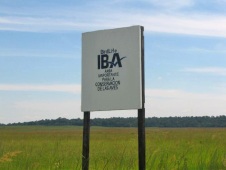
Important Bird and Biodiversity Areas (IBAs) have been identified in nearly 200 countries and territories, using a set of standardised, objective criteria, designed to select sites of global significance. In some regions, IBAs have also been selected at the regional and sub-regional levels.

A set of objective, standardised criteria has been developed for selecting Important Bird and Biodiversity Areas (IBAs) of global significance, based on the presence of species of world-wide conservation concern (Fishpool et al. 1998). A site may qualify as an IBA if it meets one or more of the following criteria:
1. Species of global conservation concern. The site is known or thought to hold, on a regular basis, significant numbers of a globally threatened bird species, or other bird species of global conservation concern.
2. Assemblage of restricted-range species. The site is known or thought to hold a significant component of the restricted-range bird species whose breeding distributions define an Endemic Bird Area (EBA).
3. Assemblage of biome-restricted species. The site is known or thought to hold a significant component of the group of bird species whose breeding distributions are largely or wholly confined to one biome.
4. Congregations. The site is known or thought to hold, on a regular basis, more than threshold numbers of a congregatory waterbird, seabird or terrestrial bird species, or to exceed thresholds set for migratory species at bottleneck sites.
These criteria are being applied globally and the process of site identification and, as shown on the map, is largely complete in Europe (Grimmett and Jones 1989, Heath and Evans 2000), the Middle East (Evans 1994), Africa (Fishpool and Evans 2001), Asia (BirdLife International 2004), Caribbean (BirdLife International 2008), the Americas (BirdLife International and Conservation International 2005, Devenish et al. 2009), Australia (Dutson et al. 2009) and Central Asia and Oceania (BirdLife International 2013). Identification work continues in parts of North America, Antarctica and in the marine realm, for which a first inventory has been published on-line (BirdLife International 2012).

The IBA criteria have, over the last 30 years, proved to be extremely effective at identifying sites of international conservation importance. To date, 9,544 IBAs of global significance have been identified in 218 countries and territories using these criteria (analysis of data held in BirdLife's World Bird Database). Similar criteria for identifying IBAs at regional and sub-regional levels have also been developed and applied in some parts of the world, with an additional 2,495 sites located so far, making more than 12,000 IBAs in total (BirdLife International 2013). For clarity, only globally significant sites are shown on the map.
Related Case Studies in other sections
Links
References
Compiled: 2004 Last updated: 2013
Recommended Citation:
BirdLife International (2013)
More than 12,000 Important Bird and Biodiversity Areas have been identified on land and at sea.
Downloaded from https://datazone.birdlife.org/sowb/casestudy/more-than-12000-important-bird-and-biodiversity-areas-have-been-identified-on-land-and-at-sea on 22/12/2024